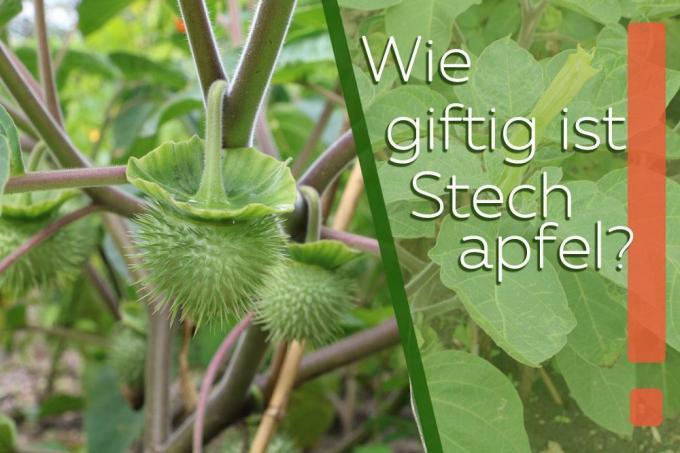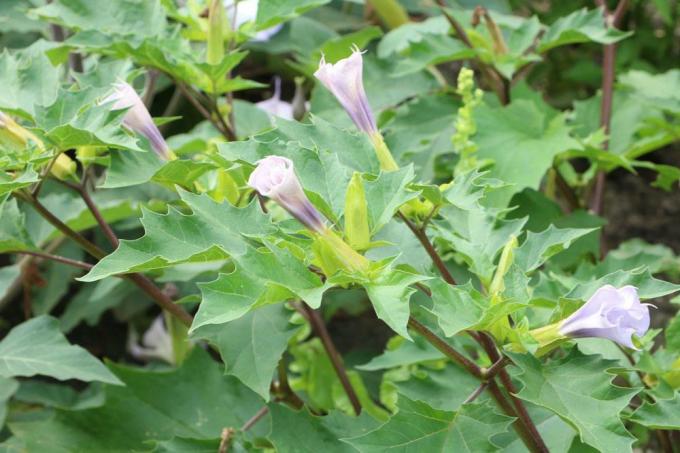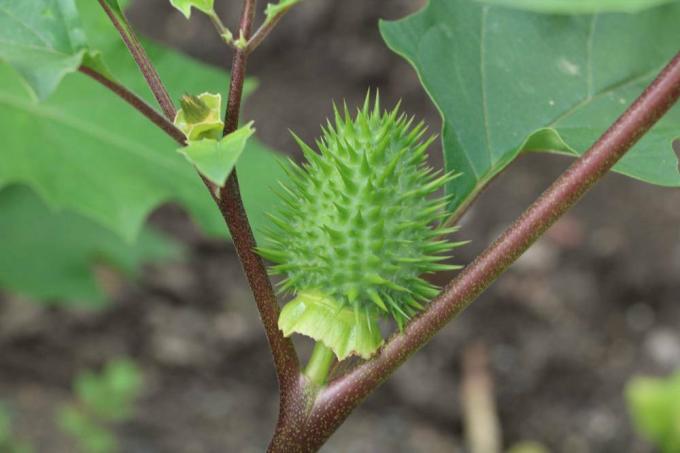
table of contents
- Thorn apple
- Is the thorn apple notifiable?
- How toxic is thorn apple?
- Thorn apple poisoning
- Recognize symptoms
- First aid
- Thorn apples as medicine
The common thorn apple (Datura stramonium) can hardly be overlooked in the garden. Its large funnel-shaped white or violet-blue flowers shine from afar. The nightshade family (Solanaceae) is nice to look at during the flowering period, exudes one lovely-sweet scent and attracts many insects, but it is nowhere near as harmless as it appears Has. Thorn apples contain toxins in all of their plant parts. Cultivation in the garden should therefore be carefully considered. Here you can find out how poisonous the thorn apple really is and whether there is an obligation to report.
Thorn apple
The annual shrub is also known under various other names such as dollkraut, sleeping apple, witch's herb or devil's apple. Very often he is doing this with his larger and far larger ones more colorful relatives, mistaken for angel trumpets (Brugmansia). Both have more or less large funnel-shaped flowers. The only difference between the plants is the orientation of the flowers and the size. Because the thorn apple is smaller and more delicate in its overall shape. The stately angel's trumpets impress with their large upside-down funnels. In contrast, in Datura stramonium, as the thorn apple is called botanically, the flowers are upright. Typical of the Dollkraut are the spiny, up to five centimeters large spherical fruits with hundreds of small, black seeds. Both plants belong to the nightshade family, are
poisonous and to be treated with caution.Note: Gloves should always be worn when handling Datura stramonium. The sap can cause skin irritation. The same applies, of course, to the angel's trumpets.
Is the thorn apple notifiable?
Although the thorn apple is poisonous in all its plant parts, it has nonetheless become a popular garden plant. The nightshade plant usually settles in the gardens by itself. The seeds are spread by birds, the wind or contaminated potting soil. Despite its toxicity, the culture is annual not notifiable.
In the right location, the plant even has the potential to be an attractive ornamental plant. It is very undemanding, easy to care for and very popular with insects. On the other hand, the thorn apples are extremely invasive. They spread very quickly by self-sowing. It is therefore advisable to remove the plants before the seeds are ripe.

Note: Due to the toxicity of all parts of the plant, cultivation in the garden should be avoided if there are small children and pets in the household.
How toxic is thorn apple?
In this country these nightshade plants are among the most poisonous plants. The main ingredients in all parts of the plant are the alkaloids
- Atropine
- Scopolamine and
- Hyoscyamine
contain. The roots and seeds of the thorn apple are particularly poisonous. Here the toxins are present in a very high concentration. However, the active ingredient content and the composition can vary depending on the weather, season and origin or The location of the plants fluctuate tremendously. Because of this, not every dose has to be equally fatal. The poison concentration can vary between 0.2 and 0.4 percent.
Consumption of this plant, mainly the seeds and leaves, can lead to health problems very quickly. Even ingesting 0.3 g of toxins can be life-threatening. Normally the lethal effect of scopolamine is at a dose of 50 g, but it can work in conjunction with the others Ingredients a much lower dose to symptoms of poisoning and ultimately death from respiratory paralysis to lead. Ingesting four to five petals in children can be fatal. The small black seeds are even more dangerous. Just five to ten grains bring a lethal dose.
Note: The cultivation of the thorn apple is not forbidden in the garden and does not require registration. The annual plant should, however, always be disposed of properly and no parts of the plant should be consumed.
Thorn apple poisoning
Occasionally, you may accidentally ingest thorn apple leaves or seeds. In most cases, however, adolescents who intentionally consume the plant parts are poisoned by the ingredients of this plant. The thorn apple leaves and seeds are used worldwide as a substitute for intoxicants and hallucigens. In most cases, the first symptoms appear after a few minutes to an hour after ingestion. Due to slower bowel movement, the condition can drag on for up to two days.
The contained alkaloids are known for their anticholinergic properties. In other words, they cancel out certain effects of the parasympathetic nervous system, a part of the autonomic nervous system. There is uncontrollability, intoxication and various symptoms of intoxication. In every respect, therefore, is definitely on duty as an intoxicant due to the high toxicity and poor controllability not advised. In general, however, you should of course stay away from all intoxicants. Even a low dosage can cause severe symptoms of intoxication with a wide variety of symptoms.

Note: Poisoning can also be aggravated by simultaneous consumption of alcohol. In addition, frequent abuse of this “drug” quickly leads to addiction.
Recognize symptoms
On the one hand, due to the different concentration of the toxins contained, a dosage can be bad Be assessed and on the other hand the symptoms that occur in the case of poisoning can be great express differently. Depending on the amount of poison ingested and depending on the person concerned, there will be more or less strong reactions. If you suspect the use of Dollkraut, you should look out for the following signs:
- Skin irritation
- high temperature
- dilated pupils and sensitivity to light
- Muscle twitching, cramps and movement disorders
- Restlessness and increased excitement
- Swallowing and speech disorders
- Visual and balance disorders
- Arrhythmias and loss of consciousness
- low blood pressure and increased heart rate
- Aggression, fits of rage and belligerence
- Thirst, dry mouth
- Nausea and vomiting
- Constipation and bladder obstruction
- Urge to talk or drowsiness
With a very high dosage, there is a strong intoxication combined with a hallucination, confusion, clouding of consciousness and optical hallucinations. An acute intoxication can therefore quickly lead to a so-called horror trip, i.e. a fearful trip. This is accompanied by anxiety, panic attacks, crying fits, loss of self-awareness, pronounced paranoia and even fear of death. The symptoms usually appear two to four hours after ingestion and can last for several days. Mainly a dilatation of the pupils can be observed over different days. In the worst case scenario, death from respiratory paralysis occurs.
Note: Since the intake of the intoxicant is usually associated with a loss of control, caution is advised, as there is an increased risk of accidents.
First aid
As soon as poisoning is recognized, intensive medical treatment must be given in the hospital as soon as possible. That includes
- a gastric lavage
- Administration of activated charcoal
- Administration of benzodiazepines and neuroleptics and
- intravenous fluids
Since a hospital is not always close by, first measures have to be taken on site. Of course, it is absolutely essential to notify an emergency doctor. Alternatively, depending on the condition of the person concerned, they can be transported to the nearest hospital as quickly as possible. Further measures are
- Contact the information center against poisoning in Bonn
- After consultation with a doctor, administration of activated charcoal
- constant control of vital functions
The first aid that is often given is strong black coffee or oak bark tea. However, this does not mean that intensive medical treatment can be dispensed with.
Thorn apples as medicine
Thousands of years ago, the narcotic and also damaging and poisonous effects of the thorn apple were known. Often they were used in ritual acts because of their hallucinogenic effects. In Europe, for the first time in the 18th In the 19th century, the Viennese doctor Anton von Stoerck officially used parts of this plant as a medicine. Very often it was used as an anticonvulsant for asthma, bronchitis and whooping cough as an expectorant. Due to the
- calming
- antispasmodic
- cough suppressant and
- pain reliever
It was also used against nervousness, neuralgia, eye injuries, infectious diseases and externally against rheumatism. Only leaves and seeds were used for treatment.
Even today, parts of this plant are often used in medicine in Eastern Europe and Western Asia. In Western Europe, however, this is no longer of great importance. It is only used in precisely defined areas of indication, but not in conventional form, but only isolated and synthetically modified extracts of the nightshade family. The powerful ingredient scopolamine is isolated and chemically changed here. Such agents are particularly effective in treating asthma, spasmodic pain in the gastrointestinal tract or the uterus.

Note: Medicines that contain active ingredients from the thorn apple require a prescription. Use is therefore only permitted under medical supervision. Self-medication is strongly discouraged.
Note: Please note that this article does not in any way replace a visit to the doctor. There is no guarantee that medical statements are correct.
You will find detailed information on first aid in the event of poisoning and important information on poison control centers here.



